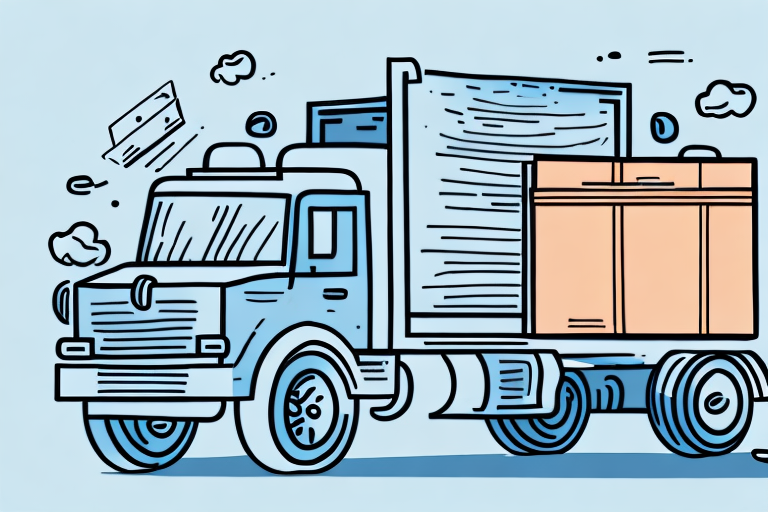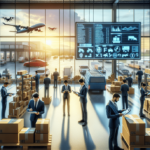Comparing Shipping and Delivery: What's the Difference?
As businesses continue to expand their reach, shipping and delivery have become integral parts of the process. However, not everyone understands the differences between the two. This article explores the basics of shipping and delivery, their histories and evolution, various types available, and their impact on businesses. Additionally, we delve into sustainability, technology, and strategies to optimize your shipping operations for efficient and effective results.
Understanding Shipping and Delivery
Definitions and Basics
At their core, shipping and delivery refer to the process of transporting products from one location to another. However, the fundamental difference lies in who is responsible for the transportation:
- Shipping: Involves transporting goods from a seller or retailer to the customer. The seller arranges the delivery and selects the appropriate carrier. The customer receives the product at their doorstep.
- Delivery: Pertains to moving packages from a single warehouse or store to the customer's specified address. Both transportation and delivery are managed by the retailer or shipping company.
For example, perishable items like food or flowers require special handling and faster delivery times to ensure they arrive in good condition. Oversized or heavy items may necessitate specialized equipment or carriers for safe transportation.
Types of Shipping
The type of shipping suitable for your business depends on your needs, the product type, and your budget:
- Ground Shipping: Transportation by truck or train. It is typically the most cost-effective option, ideal for non-urgent deliveries.
- Air Shipping: The fastest option available, suitable for products with a short shelf life or urgent delivery needs. However, it is the most expensive.
- Ocean Shipping: Ideal for bulky items that don't require quick delivery. Excellent for international transportation.
- Expedited Shipping: Faster than ground shipping but less expensive than air shipping. Suitable for businesses needing quick delivery without high costs.
Common Delivery Methods
Different delivery methods cater to varying customer preferences:
- Doorstep Delivery: Offers convenience as products are delivered directly to the customer's home.
- In-Store Pickup: Allows customers to pick up their orders at a nearby store, ideal for those who prefer not to wait for home delivery.
- Locker Pickup: Provides a secure and flexible option for customers to collect their packages from designated lockers.
History and Evolution of Shipping and Delivery
The History of Shipping and Delivery
The history of shipping and delivery dates back to ancient civilizations. The Phoenicians, for example, were renowned for transporting goods across the Mediterranean for trade. The Industrial Revolution introduced faster transportation methods such as automobiles and trains. In the 20th century, cargo planes and container ships revolutionized global trade. Today, shipping giants like FedEx and DHL dominate the industry, and innovative technologies such as drones and autonomous vehicles are shaping the future.
The Evolution of Shipping and Delivery
From horse-drawn carriages to modern drones, shipping and delivery have undergone significant transformations:
- Early Methods: Utilized animals like horses and camels for transportation.
- Industrial Advancements: Introduction of carriages, boats, and trains improved efficiency.
- 20th Century Innovations: Cargo planes and container ships enhanced global trade capabilities.
- 21st Century Technologies: Drones, autonomous vehicles, and delivery robots are revolutionizing the industry.
For instance, FedEx has been at the forefront of integrating drone technology to expedite deliveries in remote areas.
Costs and Factors Affecting Shipping
Factors That Affect Shipping Costs
Determining the cost of shipping involves several factors:
- Package Weight and Size: Heavier and larger packages incur higher shipping costs.
- Distance: Longer distances increase transportation expenses.
- Shipping Method: Faster shipping options like air increase costs compared to ground shipping.
- Fuel Prices: Fluctuations in fuel prices can affect overall shipping expenses.
- Customs Fees and Taxes: International shipments may incur additional fees.
For example, according to the Statista report, global air freight costs have risen by 15% in the past year due to increased fuel prices.
Delivery Speed and Destination
The speed and destination of your shipment also impact costs:
- Delivery Speed: Expedited shipping options result in higher costs.
- Destination: Shipping to remote or hard-to-reach areas may require additional fees.
Businesses must balance the need for speed with budget constraints to optimize shipping costs effectively.
Logistics and Operations
Understanding the Logistics of Delivery
Logistics encompasses planning, executing, and controlling the movement of products from the warehouse to the customer. Key components include:
- Warehousing: Storage and management of inventory.
- Transportation: Movement of goods via various shipping methods.
- Inventory Management: Tracking and managing product availability.
Last-mile delivery is the final leg of the delivery process, transporting products from the distribution center to the customer's address. It is often the most challenging aspect due to factors like traffic congestion and unique delivery requirements.
Tips for Efficient Operations
To optimize your shipping and delivery operations, consider the following strategies:
- Invest in Technology: Utilize route optimization software and GPS tracking to enhance delivery efficiency.
- Data Analytics: Analyze shipping data to identify trends and areas for improvement.
- Streamlined Logistics Processes: Simplify and automate processes to reduce errors and increase speed.
- Sustainable Packaging: Use recyclable or eco-friendly materials to minimize environmental impact.
Technology and Innovation in Shipping and Delivery
The Impact of Technology on Shipping and Delivery
Advancements in technology are rapidly transforming the shipping and delivery industry:
- Drones and Autonomous Vehicles: Enhance delivery speed and reach remote areas.
- Smart Containers: Equipped with sensors to monitor conditions and optimize logistics.
- Cloud Computing and Data Analytics: Streamline operations and improve decision-making.
According to a McKinsey report, the integration of AI in logistics can reduce operational costs by up to 20%.
The Future of Shipping and Delivery
Future predictions for the shipping and delivery industry include:
- Increased Use of Autonomous Vehicles: Expect widespread adoption of self-driving trucks and drones.
- Same-Day Delivery: Becoming the new standard as consumer expectations rise.
- Sustainable Shipping Operations: A greater focus on eco-friendly practices to reduce carbon footprints.
Businesses that embrace these innovations will gain a competitive edge in the market.
Case Studies: Innovative Shipping and Delivery Solutions
Successful businesses have implemented innovative shipping and delivery solutions to enhance efficiency and customer satisfaction:
- Amazon: Offers same-day delivery in select cities and is pioneering drone delivery through Amazon Prime Air.
- UPS and FedEx: Testing drone delivery services to expedite deliveries in urban and remote areas.
- Walmart: Experimenting with self-driving delivery trucks to increase delivery speed and reduce costs.
These companies demonstrate the benefits of adopting new technologies early, providing significant competitive advantages.
Sustainability in Shipping and Delivery
With increasing awareness of environmental impacts, businesses are striving to reduce their carbon footprint in shipping and delivery:
- Electric Vehicles: Utilizing electric trucks and delivery vans to lower emissions.
- Sustainable Packaging: Implementing recyclable or biodegradable packaging materials.
- Renewable Energy: Investing in renewable energy sources to power logistics operations.
According to the Environmental Protection Agency, sustainable shipping practices can reduce greenhouse gas emissions by up to 30%.
Adopting sustainable practices not only benefits the environment but also enhances brand reputation among environmentally conscious consumers.
International Shipping and Delivery
International shipping and delivery present unique challenges, including:
- Customs Regulations: Navigating varying international laws and import/export restrictions.
- Currency Exchange Rates: Managing costs associated with fluctuating exchange rates.
- Shipping Costs: Higher expenses due to longer distances and additional fees.
Working with a trusted carrier experienced in international shipments, such as ShipScience International Services, can simplify the process and ensure timely delivery.
It's also essential to provide accurate documentation and understand the customs requirements of each destination country to avoid delays and additional costs.
Conclusion
While shipping and delivery may seem interchangeable, they refer to two distinct processes. Shipping entails transporting products from the retailer or seller to the customer, whereas delivery involves moving products from the warehouse to the customer's doorstep. Understanding the differences, types, and factors influencing shipping and delivery can help businesses make informed decisions to optimize operations and provide excellent customer service.




















